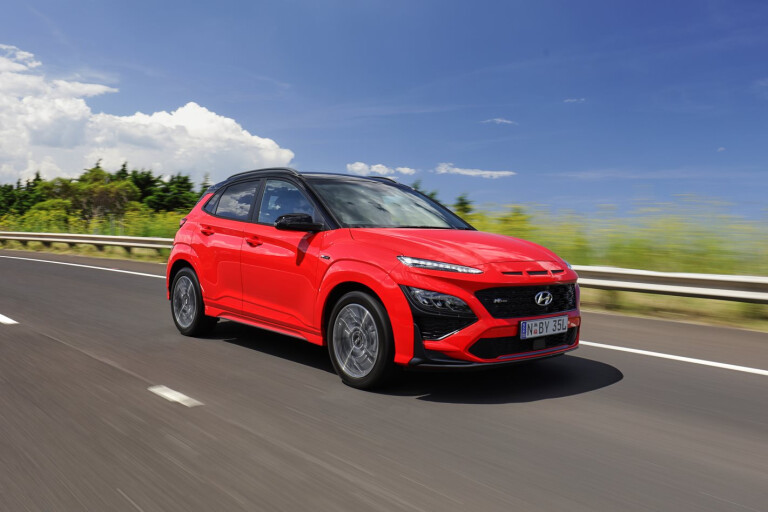
What is the Hyundai N Line Premium?
It seems as if a subgenre of warmed-over compact and small SUVs and crossovers has suddenly become motoring’s hot new ticket. It stands to solid reason, too, as growing demands for smart tech and safety elevates yesterday’s cheap and cheerless into increasingly accomplished pint-sized quality delivered, of course, at an extra cost. An overtly sporting spin, then, makes a more serious outlay more palatable.
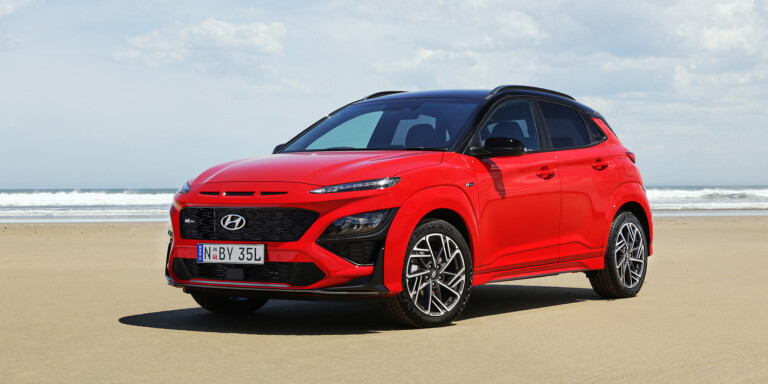
The Kona N Line debuts Hyundai’s carefully cultivated performance N branding in SUV form. It takes on the VW T-Roc, Toyota CH-R GR Sport, Skoda Kamiq Monte Carlo, Audi Q2 and eleventy-thousand other gym-toned urban-centric runabouts since, it seems, Mercedes-Benz dared to affix an AMG badge to its GLA compact crossover.
The Korean upstart arrives in sharper facelifted form, festooned with N leisurewear, looking fast standing still and marking the sport-themed versions – regular N Line and flagship N Line Premium as tested here – as the cream of the Kona crop.

Appearance is nigh on indistinguishable between the two grades and it is easily the best Kona looker to date, which fits its technical superiority over the regular have-not variants. The N Lines pack 1.6-litre turbo-petrol power, a dual-clutch transmission, all-wheel drive and a multilink rear suspension. And if you’re thinking: hang about, you can get all of that stuff on any of the regular Konas, well, no you can’t. Not anymore, in facelift form.
Range consolidation, as Hyundai puts it, has left the four-tier pedestrian Kona range with what was and remains the lower-grade underpinnings: naturally aspirated engines, front drive, a torsion beam rear end and, now, a CVT transmission.
A sceptical glance suggests Hyundai hasn’t so much upgraded Kona to N Line spec but downgraded everything else. And perhaps simply carried over the old technical package dressed in a new tracksuit. But digging further reveals there are some new tricks with the N Line formula, even if mechanical gems, including a whole new engine, are rarities. And it carries over from old 1.6 AWD foundations that were quality to begin with and mightn’t have warranted overhauling.
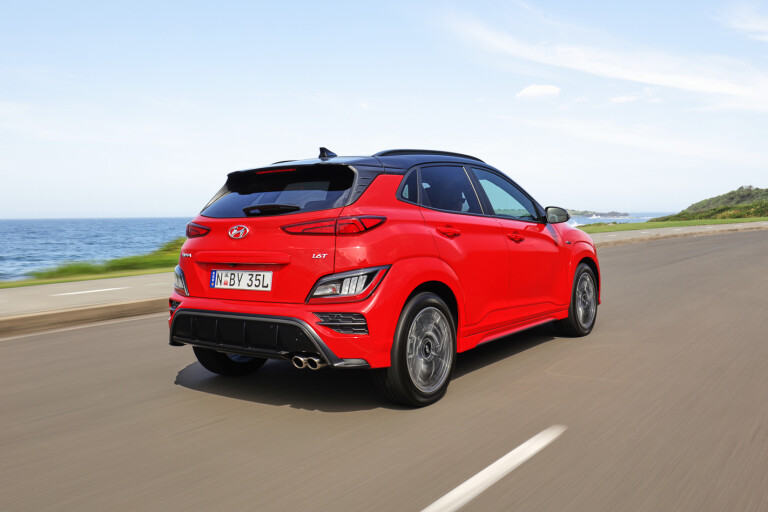
Of course, you could spot in a blizzard that this is no stove-hot i30 N wrapped in more lifestyle flexible packaging, even if it arguably looks the part. The question is whether Kona N Line can blend old and new goodness with enough genuine warmth to not hold back Hyundai’s N brand aspirations.
Price and Value
The N Line Premium sits at the top of the Kona tree at $42,400 before on-roads. Essentially, it shares identical running gear and other N-spec accoutrements with the regular N Line that’s $8100 more affordable ($36,300 before onroad costs) but includes the full bells and whistles suite as featured on the high-spec Highlander ($38,000 before ORC) as a sort of best-of amalgamation.
That’s the rich fringes of mainstream small SUV-dom. And segment semantics aside, those primarily after a stylised urban runabout big on badge cache can tip into humble-spec, low-hanging Audi and Lexus options.
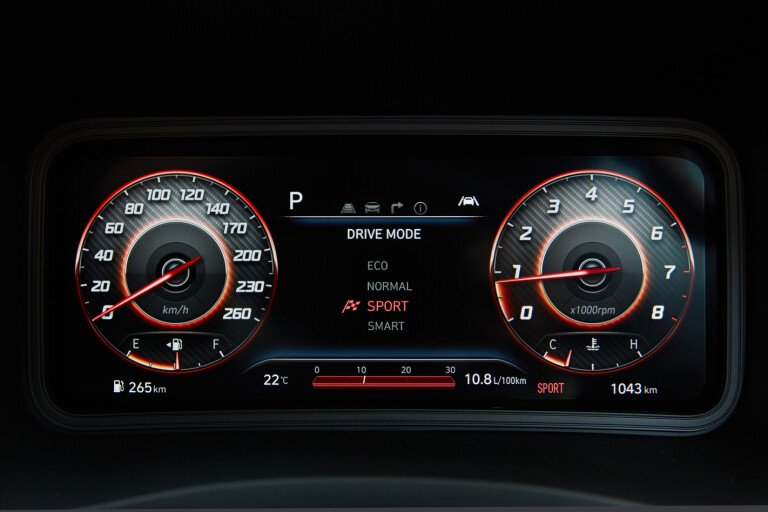
The Premium fits 18-inch wheels, all-speed AEB with pedestrian and cyclist detection, adaptive cruise control, larger 305mm front brakes, partial leather trim, 10.25-inch sat-nav-equipped infotainment, Apple CarPlay and Android Auto smartphone mirroring and inductive phone charging. But then again, so does the regular N Line, which is based off Elite-grade feature fitment.
The key lure for the Premium’s $8100 upcharge is the 10.25-inch digital driver’s instrumentation though the high-spec version adds other dangling carrots such as full LED lighting, front parking sensors, a head-up display, ambient lighting, seat heating is both rows plus cooling up front, high-beam assist and glass sunroof, although the last item gets deleted if you opt for two-tone paint that adds a black roof.
In value terms, the more affordable regular N Line is more compelling given that you lose nothing in core goodness and only economise in details such as analogue instrumentation and halogen headlights.
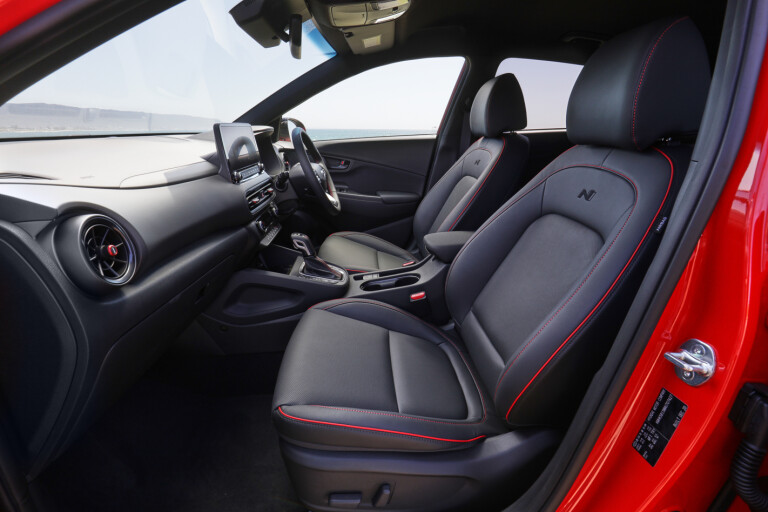
Living with the Hyundai Kona N Line Premium
There’s more to the N Line’s exterior mojo than the Kona family’s wider grille and remodelled headlight treatment. The colour-matched the wheelarch cladding, side skirts and diffuser-look tail treatment, specific N mesh grille and front end contours all conspire to deliver a more hunkered-down tarmac-friendly stance and the soft-roader aesthetic favoured in the rest of the range. Its look alone is easily worth a decent chunk of the splurge for the sporty variants.
The cabin is less inspired, a design left largely untouched in the facelift process that’s neat and presentable if lacking a sense of adventure, particularly the almost monochromic grey-out effect with sport-by-the-numbers red striping and stitching. The sea of plastic, as sturdy and nicely textured as it is, doesn’t exactly do this variant’s flagship status any favours. Hyundai could well invest in bit more colour and materialistic joy in trade for some token appointments such as a rear outboard seat heaters.
Seat contouring, padding and perforated surfacing are decent rather than exceptional, comfort-leaning pews favouring long commuting that could do with a little more lateral support. Driver ergonomics, though, are fine, with a waxy leather wheel rim, quality touch points and natural control location.

Pride of place is the 10.25-inch digital driver’s screen, and it’s a mixed bag. It’s sharp in resolution, rich in colour and its trio of distinctively different display skins that swap in tandem with drive modes are all legible at a glance. The downside is that it’s a rectangular screen plonked in a rectangular and weirdly framed aperture with little concession to binnacle stylisation that smacks of afterthought.
By contrast, the identically sized infotainment screen seems much larger and more upmarket simply through more resolved integration. It’s a decent system, with a nifty split-screen option and some landing pages burgeoning to distraction with options if with fine navigation facility and wondrous quirks such as near pointless Sounds Of Nature that pipes ambient tracks into the audio stream – we’re talking footstep through snow, clanging crockery or, even stranger, water through plumbing – as if to coerce you into comfort breaks on long trips.
And, yet there are no rear air vents for row two passengers.
Rear passenger space has long been at a premium for Kona and this facelifted and sport-augmented version doesn’t improve things one bit. The lack of cabin depth leaves limited legroom behind taller front occupants, and headroom and elbow room are both merely adequate. If genuine four-adult – let alone five-adult – accommodation is a need, best shop elsewhere. A single USB-A port as the notable creature comfort in the back doesn’t cut it for a small SUV sailing north of the $40K.
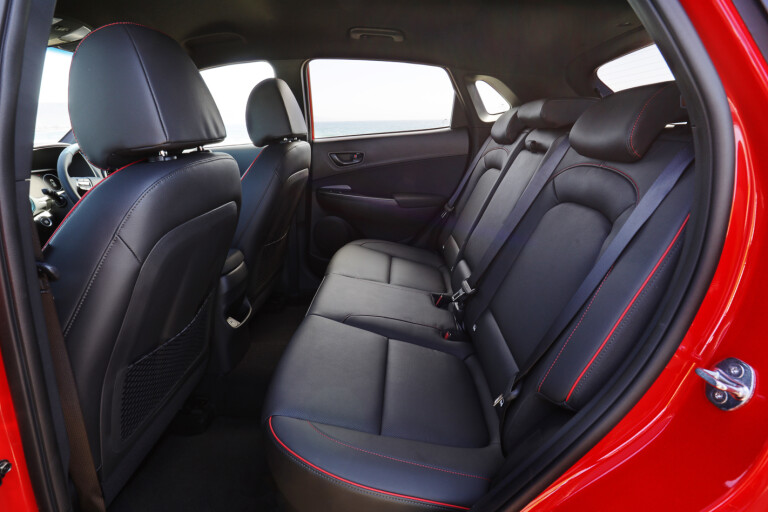
Kona’s modest 371-litre boot space is adequate for groceries and small cases but the high-set floor robs some utility. The elasticised net is a nice inclusion though the lack of tailgate power assistance is quite an omission for the coin N Line Premium asks for.
Engine, transmission and driveline
The N Line’s heartbeat is the newest, most substantial addition to the Kona menu. The G1.6T-GDi SmartStream engine is all-new for the range, having only previously been offered in the recently released i30 Sedan N Line and, unlike the old 1.6-litre turbo four-cylinder unit features continuously variable valve duration (CVVD) top-end trickery.
The SmartStream engine ups power to 146kW (at 6000rpm), a 16-kilowatt hike over the unit it replaces, though torque remains at a fairly healthy 265Nm from just 1600rpm through to 4500rpm. According to Hyundai, CVVD doesn’t conspire to liberate higher power in the upper rev-range – though redline is 500rpm up on the old engine – but its mandate is to fatten torque in lower revolutions and return improved fuel economy at theoretical parity horsepower.
Fine, though the upshot of a rough 10 per cent power hike in this new combination nets a slightly thirstier advertised combined consumption (6.9L/100km) that’s 0.2L higher than its predecessor. The good news, though, is that it’ll run on crappy 91RON fuel where many competitors’ small-capacity turbo mills demand 95RON. If you choose, it’s also happy on E10.
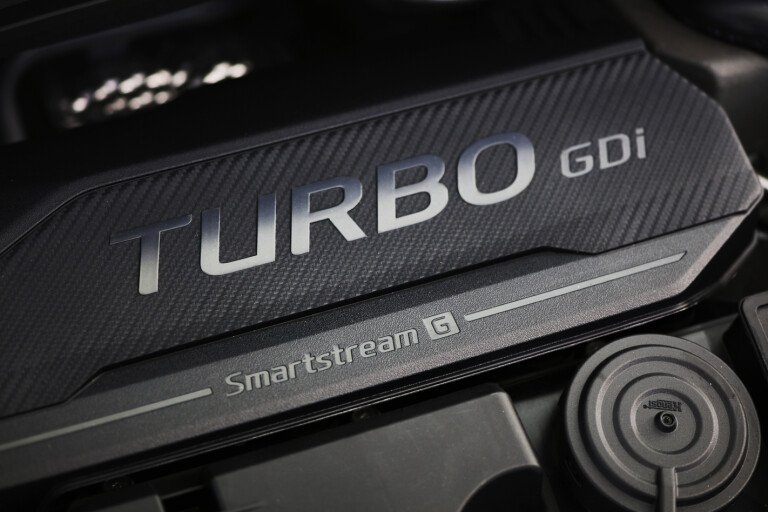
Downstream the N Line powertrain is more familiar. The seven-speed dry-dual-clutch transmission is mechanically carryover though it does benefit from new calibration. Torque is sent through the on-demand all-wheel-drive system that offers a 50/50 front and rear lock mode at speeds under 50km/h at a touch of a button.
N Line’s front brakes are 305mm in diameter, which is 25mm up on regular Kona spec. Handy, too, because in its lightest advertised form the 1.6-litre AWD versions are (at 1395kg) around 115kg heavier than the 2.0-litre front drivers.
Interestingly, according to Hyundai Australia, there has been no change in suspension tune between the N Line and outgoing multilink-rear variants, and the rationale behind it is two-fold. Firstly, there was so much investment in and positive outcome from its Aussie development the first time around that it was ‘right’ out of the box. And secondly, the existing tune worked so well in conjunction with an upgrade to 235mm Continental PremiumContact 6 tyres that no further fiddling was deemed necessary.
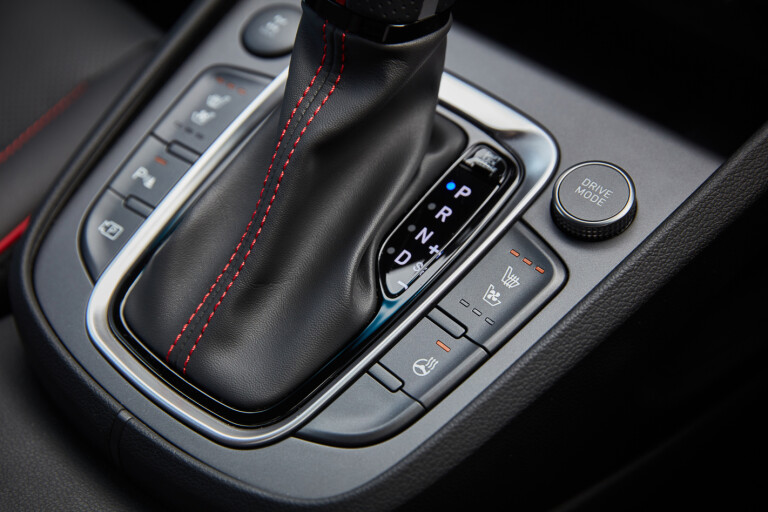
Driving the Hyundai Kona N Line Premium
Indeed, those suspension boasts aren’t mere spindoctoring. The hands-down highlight of the on-road N Line experience is the ride and handling balance.
Insider lore is that Hyundai Australia’s local car launch drive programs take few prisoners, particular on the topic of N-related machinery. Memory serves that on i30 N’s debut across the the Snowy Mountain’s finest roads, corner-carving was so relentless and exhaustive that one journalist made himself carsick.
Kona N Line’s curated launch route made a back-road beeline west through regional New South Wales, with big stretches of narrow and unforgiving blacktop blessed with surprisingly liberal speed limits given the scant margin for error and the odd crest that just might’ve separated Continentals form the actual continent below them. Plus, as a punctuation of sorts, long stints of fast-flowing if only moderately maintained gravel road look lifted from a stage of WRC.
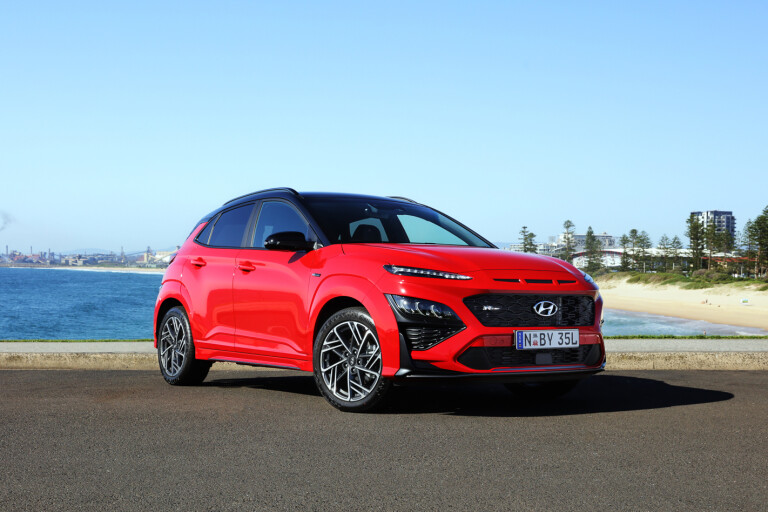
N Line’s natural state is slightly firm with surprisingly pliant compression and fast-settling rebound. It’s not so evident around town unless you’re careening over speed bumps like a loon but out threading a needle across farmland with a head full of steam and a close eye on the speedo, the wheel control the Kona directs while maintaining flat composure and a firm grip on body control is, at times, miraculous.
There’s nothing brittle or terse about the chassis. In fact, its compliance is such that you seriously doubt it’ll hunker down quite as neatly as it does, loading up its Conti’s just nicely, and hooking through that lumpy off-camber sweeper with the poise and control of a thoroughbred. Steering, too, is crisp, direct and linear, compounding in a machine that flows nicely and carries heady velocity without demanding a lot of driver input or correction.
Okay, it’s not weapons-grade performance, and its dynamic limitations aren’t stratospheric, but as a driving tool it punches very high for what it is: a warmed up crossover. It’s a predictable and cooperative ally if you feel like a decent punt, capable enough that you’ll be enticed to take routes less trodden in the pursuit of grand touring.
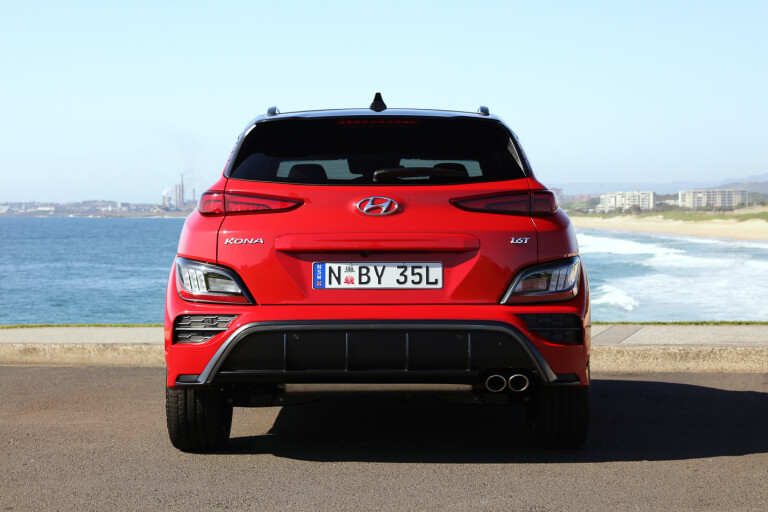
The powertrain, too, is at its fittest on the move with Sport drive mode selected. Thus set, the turbo four’s torque swells nicely in the mid-range and the dual-clutch transmission is generally cluey enough to hover the engine around its sweet spot. Too many revs and the 1.6’s shove tends to wane a bit and you’re compelled to build pace through the chassis rather than wringing out the last of the engine’s moderate output. Besides, with no paddle-shifters fitted to manually harness the turbo mill’s best, you’re left to negotiate pace with the gearbox ECU.
Tone your enthusiasm down – in Eco, Normal or Smart drive mode, whatever the choice - and the powertrain errs a little too much towards thriftiness, the engine dulling response by some measure and the dual-clutch overly keen to seek high ratios to save fuel. There’s enough muscle in the undertow for generally unflustered progress, but it’s a pusher not a puncher and any call to arms demands you knock the transmission controller in Sport mode for enough of a wake-up call.

Dual-clutch Konas were notoriously grumpy, but this new calibration really slips through ratios cleanly, even at crawling peak-hour pace. But there seems to be a trade-off in the quest for polished dignity: trounce the loud pedal from standstill and Kona N Line refuses to pluck many engine revs, responding with a moment of pause before it builds into acceleration.
Gearbox self-preservation protocols? Perhaps. But off-the-mark performance isn’t Kona N Line’s strong suit and pulling out of a side street onto a 110km/h motorway into that gap between B-doubles demands precision and a very heavy right foot.
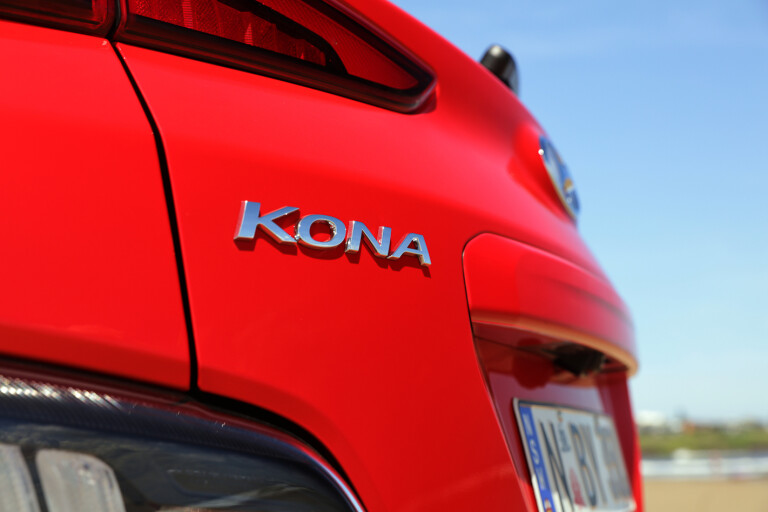
How safe is the Hyundai N Line Premium?
This facelift carries over the Kona’s five-star ANCAP rating from a 2017 assessment.
Hyundai bolstered the wider Kona range’s active safety credentials in this 2021 facelift and the N Line Premium is treated to the full load. Features include camera and radar autonomous emergency braking with pedestrian and cyclist detection, both active lane keep and lane following, blind-spot warning (with braking avoidance if required), rear cross traffic assist, exit warning (when opening doors in traffic) and high-beam assist.
Add driver attention warning and rear occupant alert and the six-airbag Kona certainly offers well-rounded safety credentials.
Everything you want to know about the new i30 N
How much does it cost to run the Hyundai N Line Premium?
Servicing intervals are every 12 months or 10,000km, whichever comes first, which is shorter than the 15,000km cap on the naturally aspired Kona if not unusual for small-capacity turbocharged engines such as the G1.6 T-GDi.
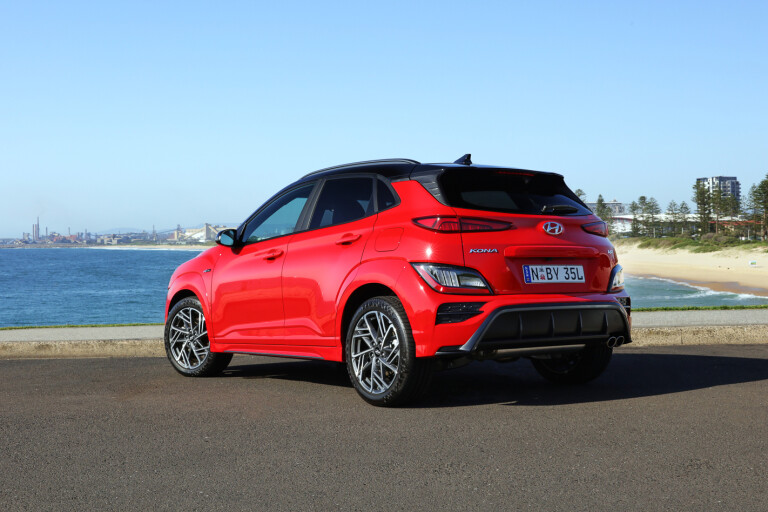
Hyundai Australia hadn’t finalised pricing for its pre-paid servicing packages for MY21 Kona at the time of writing. As a guide, the pre-facelift 1.6 AWD Highlander costs $822 for the first three years (30,000km) and $1430 for a five-year (50,000km) package paid upfront.
The Kona N Line is covered by Hyundai’s five-year/unlimited-kilometre warranty.
During our assessment, the Kona N Line returned consumption of between 6.1 litres and 9.5 litres per 100km, depending on driving conditions, against its advertised claim of 6.9L/100km. That’s decent given a lot of the flying was low and reasonably hard. As mentioned above, official literature states the 1.6 turbocharged four-cylinder will run happily on 91RON or E10 fuel.
Verdict
While Hyundai offers its luxury-focused Highlander in 2.0-litre CVT front-driven form, the cream of the Kona crop is the N Line Premium for all-in sporting and luxury goodness. On balance, it’s more accomplished in its sporting role, but despite some powertrain lethargy it makes for a damn fine everyday around town prospect.

Pricing is getting up there, but its qualities as a fine all-rounder should certify its place on your short list if shopping for a want-for-little warmed over crossover. Or cool your jets for the forthcoming proper N version if genuine thrills are a major priority.
Rating 4.0/5.0
Rating breakdown
Value 3.8/5.0
Safety 4.3/5.0
Running costs 4.0/5.0
Comfort and practicality 4.0/5.0
On the road 4.0/5.0
What you will like
Ride and handling balance, smart looks, decent power
What you won’t
Powertrain lethargy at a cruise, pricing on the high side
Specifications – Hyundai Kona N Line Premium
Price: From $42,400 pls ORC (7DCT)
Engine/transmission: 1.6-litre 4cyl turbo petrol/7DCT, AWD on demand
Fuel consumption/CO2/tank size: 6.9L/100km, 156g/km, 50 litres
Safety: 5 stars
Seats: 5
Warranty/service interval: five years/unlimited, 10,000km/12 months
Spare wheel (type): space saver
Weight: from 1395kg



COMMENTS